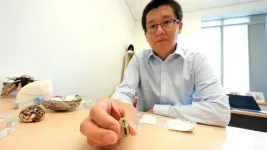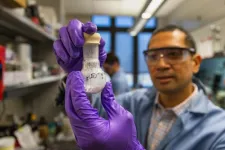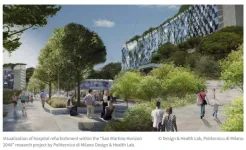(Press-News.org) CAMBRIDGE, Mass. -- Aviation’s huge carbon footprint could shrink significantly with electrification. To date, however, only small all-electric planes have gotten off the ground. Their electric motors generate hundreds of kilowatts of power. To electrify larger, heavier jets, such as commercial airliners, megawatt-scale motors are required. These would be propelled by hybrid or turbo-electric propulsion systems where an electrical machine is coupled with a gas turbine aero-engine.
To meet this need, a team of MIT engineers is now creating a 1-megawatt motor that could be a key stepping stone toward electrifying larger aircraft. The team has designed and tested the major components of the motor, and shown through detailed computations that the coupled components can work as a whole to generate one megawatt of power, at a weight and size competitive with current small aero-engines.
For all-electric applications, the team envisions the motor could be paired with a source of electricity such as a battery or a fuel cell. The motor could then turn the electrical energy into mechanical work to power a plane’s propellers. The electrical machine could also be paired with a traditional turbofan jet engine to run as a hybrid propulsion system, providing electric propulsion during certain phases of a flight.
“No matter what we use as an energy carrier — batteries, hydrogen, ammonia, or sustainable aviation fuel — independent of all that, megawatt-class motors will be a key enabler for greening aviation,” says Zoltan Spakovszky, the T. Wilson Professor in Aeronautics and the Director of the Gas Turbine Laboratory (GTL) at MIT, who leads the project.
Spakovszky and members of his team, along with industry collaborators, will present their work at a special session of the American Institute of Aeronautics and Astronautics – Electric Aircraft Technologies Symposium (EATS) at the Aviation conference in June.
The MIT team is composed of faculty, students, and research staff from GTL and the MIT Laboratory for Electromagnetic and Electronic Systems: Henry Andersen Yuankang Chen, Zachary Cordero, David Cuadrado, Edward Greitzer, Charlotte Gump, James Kirtley, Jr., Jeffrey Lang, David Otten, David Perreault, and Mohammad Qasim, along with Marc Amato of Innova-Logic LLC. The project is sponsored by Mitsubishi Heavy Industries (MHI).
Heavy stuff
To prevent the worst impacts from human-induced climate change, scientists have determined that global emissions of carbon dioxide must reach net zero by 2050. Meeting this target for aviation, Spakovszky says, will require “step-change achievements” in the design of unconventional aircraft, smart and flexible fuel systems, advanced materials, and safe and efficient electrified propulsion. Multiple aerospace companies are focused on electrified propulsion and the design of megawatt-scale electric machines that are powerful and light enough to propel passenger aircraft.
“There is no silver bullet to make this happen, and the devil is in the details,” Spakovszky says. “This is hard engineering, in terms of co-optimizing individual components and making them compatible with each other while maximizing overall performance. To do this means we have to push the boundaries in materials, manufacturing, thermal management, structures and rotordynamics, and power electronics.”
Broadly speaking, an electric motor uses electromagnetic force to generate motion. Electric motors, such as those that power the fan in your laptop, use electrical energy — from a battery or power supply — to generate a magnetic field, typically through copper coils. In response, a magnet, set near the coils, then spins in the direction of the generated field and can then drive a fan or propeller.
Electric machines have been around for over 150 years, with the understanding that, the bigger the appliance or vehicle, the larger the copper coils and the magnetic rotor, making the machine heavier. The more power the electrical machine generates, the more heat it produces, which requires additional elements to keep the components cool — all of which can take up space and add significant weight to the system, making it challenging for airplane applications.
“Heavy stuff doesn’t go on airplanes,” Spakovszky says. “So we had to come up with a compact, lightweight, and powerful architecture.”
Good trajectory
As designed, the MIT electric motor and power electronics are each about the size of a checked suitcase weighing less than an adult passenger.
The motor’s main components are: a high-speed rotor, lined with an array of magnets with varying orientation of polarity; a compact low-loss stator that fits inside the rotor and contains an intricate array of copper windings; an advanced heat exchanger that keeps the components cool while transmitting the torque of the machine; and a distributed power electronics system, made from 30 custom-built circuit boards, that precisely change the currents running through each of the stator’s copper windings, at high frequency.
“I believe this is the first truly co-optimized integrated design,” Spakovszky says. “Which means we did a very extensive design space exploration where all considerations from thermal management, to rotor dynamics, to power electronics and electrical machine architecture were assessed in an integrated way to find out what is the best possible combination to get the required specific power at one megawatt.”
As a whole system, the motor is designed such that the distributed circuit boards are close coupled with the electrical machine to minimize transmission loss and to allow effective air cooling through the integrated heat exchanger.
“This is a high-speed machine, and to keep it rotating while creating torque, the magnetic fields have to be traveling very quickly, which we can do through our circuit boards switching at high frequency,” Spakovszky says.
To mitigate risk, the team has built and tested each of the major components individually, and shown that they can operate as designed and at conditions exceeding normal operational demands. The researchers plan to assemble the first fully working electric motor, and start testing it in the fall.
Once the MIT team can demonstrate the electric motor as a whole, they say the design could power regional aircraft and could also be a companion to conventional jet engines, to enable hybrid-electric propulsion systems. The team also envision that multiple one-megawatt motors could power multiple fans distributed along the wing on future aircraft configurations. Looking ahead, the foundations of the one-megawatt electrical machine design could potentially be scaled up to multi-megawatt motors, to power larger passenger planes.
“I think we’re on a good trajectory,” says Spakovszky, whose group and research have focused on more than just gas turbines. “We are not electrical engineers by training, but addressing the 2050 climate grand challenge is of utmost importance; working with electrical engineering faculty, staff and students for this goal can draw on MIT’s breadth of technologies so the whole is greater than the sum of the parts. So we are reinventing ourselves in new areas. And MIT gives you the opportunity to do that.”
###
Written by Jennifer Chu, MIT News Office
END
Megawatt electrical motor designed by MIT engineers could help electrify aviation
Technology demonstrations show the machine’s major components achieve the required performance.
2023-06-09
ELSE PRESS RELEASES FROM THIS DATE:
Ling Li leads team to see through eyes made of stone
2023-06-09
Ling Li, associate professor in the Department of Mechanical Engineering, has been awarded $1.05 million over three years to lead a team studying the visual abilities of a unique underwater creature with thousands of eyes.
The project reunites Li with a former collaborator, University of South Carolina Associate Professor Daniel Speiser. They also enlisted the expertise of an internationally recognized applied mathematician who specializes in image processing, Daniel Baum of the Zuse Institute in Berlin.
What stony eyes see and what it means
The team’s research will focus on the stony eyes of chitons. These marine creatures have pill-shaped, hard outer ...
Proof-of-Concept Program funds 12 research projects
2023-06-09
Virginia Tech Intellectual Properties (VTIP) with LINK + LICENSE + LAUNCH’s Proof-of-Concept Program has provided the springboard for faculty to bring their research to market. Over the past four years, the program has funded 24 Virginia Tech research projects.
“We are excited to be able to support a larger group of proof-of-concept projects in this award cycle,” said Mark Mondry who leads LAUNCH. “Several of the Virginia Tech faculty-led projects in this round include collaborations with students, industry partners, and other academic institutions, bringing diverse perspectives to the project ...
Community Design Assistance Center helps create opportunities in rural Virginia
2023-06-09
The rundown facade of the Thomas Deen building in St. Paul, Virginia, belied the once-impressive department store's better days.
The four-story brick building opened its doors to customers in the early 1920s, but over time, the structure was as forgotten as the discarded tires it housed some 100 years later. As Elizabeth Gilboy, the director of the Community Design Assistance Center, an outreach center in Virginia Tech's College of Architecture, Arts, and Design, and the center's team explored the site in fall 2020, they recognized their unique place at the intersection of the building's history and future.
Since ...
WHO recommends Politecnico di Milano guidelines for the design of future hospitals
2023-06-09
Milan, 9 June 2023 - The World Health Organisation presented in Baku (Azerbaijan) the new design recommendations for new hospitals to be built in the European Region, the result of a research partnership with the Politecnico di Milano. The document was prepared by the Design & Health Lab in the Department of Architecture, Construction Engineering and the Built Environment at the Politecnico under the coordination of Professor Stefano Capolongo.
The COVID-19 pandemic highlighted the importance of preparedness for natural and man-made disasters, emergencies and other social crises. The ability to provide continuous ...
3D 'bio-printing' inside hydrogels
2023-06-09
Scientists from the NIHR Great Ormond Street Hospital Biomedical Research Centre (a collaboration between GOSH and UCL), London, and University of Padova, Italy, have shown for the first time how 3D printing can be achieved inside ‘mini-organs’ growing in hydrogels -- controlling their shape, activity, and even forcing tissue to grow into 'moulds.'
This can help teams study cells and organs more accurately, create realistic models of organs and disease, and even better understand how cancer spreads through different tissues.
A particularly promising area of research at the Zayed Centre for Research ...
Scientists make a surprising discovery about magnetic defects in topological insulators
2023-06-09
Scientists from the Department of Energy’s Ames National Laboratory made an intriguing discovery while conducting experiments to characterize magnetism in a material known as a dilute magnetic topological insulator where magnetic defects are introduced. Despite this material’s ferromagnetism, the team discovered strong antiferromagnetic interactions between some pairs of magnetic defects that play a key role in several families of magnetic topological insulators.
Topological insulators (TIs) as their name indicates, ...
Novel ferroelectrics for more efficient microelectronics
2023-06-09
When we communicate with others over wireless networks, information is sent to data centers where it is collected, stored, processed, and distributed. As computational energy usage continues to grow, it is on pace to potentially become the leading source of energy consumption in this century. Memory and logic are physically separated in most modern computers, and therefore the interaction between these two components is very energy intensive in accessing, manipulating, and re-storing data. A team of researchers from Carnegie Mellon University and Penn State University is exploring materials that could possibly lead to the ...
Quantum materials: Electron spin measured for the first time
2023-06-09
An international research team has succeeded for the first time in measuring the electron spin in matter - i.e., the curvature of space in which electrons live and move - within "kagome materials", a new class of quantum materials.
The results obtained - published in Nature Physics - could revolutionise the way quantum materials are studied in the future, opening the door to new developments in quantum technologies, with possible applications in a variety of technological fields, from renewable energy to biomedicine, from electronics to quantum computers.
Success was ...
Seismic Waves tell lithospheric delamination mechanism in south China
2023-06-09
A research team led by Prof. ZHANG Haijiang from the University of Science and Technology of China (USTC) of the Chinese Academy of Sciences, and Prof. HOU Zengqian from Chinese Academy of Geological Sciences, revealed the seismically imaged lithospheric delamination and its controls on the Mesozoic Magmatic Province in South China by using a new joint seismic inversion algorithm. The study was published in Nature Communications.
Based on the latest developed seismic joint inversion algorithm, the researchers made use of the seismic body wave travel time, surface wave dispersion ...
Program for underrepresented undergraduate students in STEM receives NIH funding
2023-06-09
Alexandra Hanlon, director of the Virginia Tech Center for Biostatistics and Health Data Science, was recently awarded a $1.25 million grant from the National Institutes of Health (NIH) for a summer program aimed at promoting and diversifying the field of collaborative biostatistics.
The Collaborative Undergraduate Biostatistics Experience (CUBE), an eight-week summer program geared toward underrepresented undergraduate students, will receive $250,000 per year over the next five years through the NIH Research Education Program.
This R25 award, which is funded in a joint effort ...
LAST 30 PRESS RELEASES:
Injectable breast ‘implant’ offers alternative to traditional surgeries
Neuroscientists devise formulas to measure multilingualism
New prostate cancer trial seeks to reduce toxicity without sacrificing efficacy
Geometry shapes life
A CRISPR screen reveals many previously unrecognized genes required for brain development and a new neurodevelopmental disorder
Hot flush treatment has anti-breast cancer activity, study finds
Securing AI systems against growing cybersecurity threats
Longest observation of an active solar region
Why nail-biting, procrastination and other self-sabotaging behaviors are rooted in survival instincts
Regional variations in mechanical properties of porcine leptomeninges
Artificial empathy in therapy and healthcare: advancements in interpersonal interaction technologies
Why some brains switch gears more efficiently than others
UVA’s Jundong Li wins ICDM’S 2025 Tao Li Award for data mining, machine learning
UVA’s low-power, high-performance computer power player Mircea Stan earns National Academy of Inventors fellowship
Not playing by the rules: USU researcher explores filamentous algae dynamics in rivers
Do our body clocks influence our risk of dementia?
Anthropologists offer new evidence of bipedalism in long-debated fossil discovery
Safer receipt paper from wood
Dosage-sensitive genes suggest no whole-genome duplications in ancestral angiosperm
First ancient human herpesvirus genomes document their deep history with humans
Why Some Bacteria Survive Antibiotics and How to Stop Them - New study reveals that bacteria can survive antibiotic treatment through two fundamentally different “shutdown modes”
UCLA study links scar healing to dangerous placenta condition
CHANGE-seq-BE finds off-target changes in the genome from base editors
The Journal of Nuclear Medicine Ahead-of-Print Tip Sheet: January 2, 2026
Delayed or absent first dose of measles, mumps, and rubella vaccination
Trends in US preterm birth rates by household income and race and ethnicity
Study identifies potential biomarker linked to progression and brain inflammation in multiple sclerosis
Many mothers in Norway do not show up for postnatal check-ups
Researchers want to find out why quick clay is so unstable
Superradiant spins show teamwork at the quantum scale
[Press-News.org] Megawatt electrical motor designed by MIT engineers could help electrify aviationTechnology demonstrations show the machine’s major components achieve the required performance.





